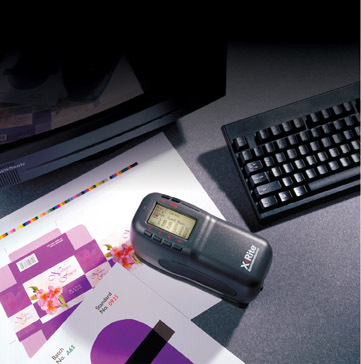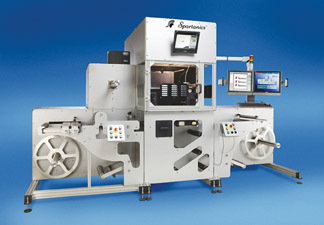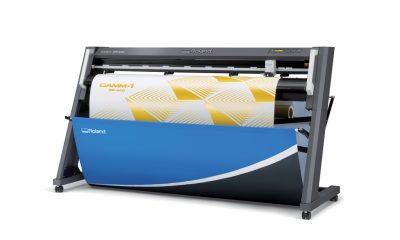Graphics Printing
Published
16 years agoon

Is a color hot pink or flamingo? Forest green or hunter green? Where an ink mixer sees sky blue, does the customer see powder blue? The labels humans use to identify the world of color reflect the subjective nature of color perception and hint at the challenges a screen printer faces in matching colors correctly. The printer’s problems only escalate when we consider the factors that influence perception, from viewing environment to metamerism—the phenomenon by which two color samples may appear identical under some lighting conditions, but not others.
Is a color hot pink or flamingo? Forest green or hunter green? Where an ink mixer sees sky blue, does the customer see powder blue? The labels humans use to identify the world of color reflect the subjective nature of color perception and hint at the challenges a screen printer faces in matching colors correctly. The printer’s problems only escalate when we consider the factors that influence perception, from viewing environment to metamerism—the phenomenon by which two color samples may appear identical under some lighting conditions, but not others. These obstacles can make accurate color matching as futile as searching for the pot of gold at the end of a rainbow.
But the gold is well within reach, thanks to the spectrophotometer. Spectrophotometers, or “spectros” as they’re referred to by their manufacturers, are designed to evaluate colors in ways similar to the human eye. But unlike subjective human perception, spectrophotometers measure colors by their spectral values, which remain constant regardless of lighting condition.
Spectrophotometers measure color reflectance quantitatively within the visible spectrum (wavelengths of approximately 360-750 nanometers). The devices report color values as numbers in a three-dimensional color space (e.g., L*a*b), thereby transcending vague color names such as midnight blue and candy-apple red. And when used with modern color-management software, these tools allow you to store and recall color information on a computer, making it possible to deliver accurate colors time and again on repeat orders.
How spectrophotometers work
Reflective spectrophotometers are the most common form (tranmissive models will be discussed later) and are typically solid-state devices that rely on a small number of complex parts to do their jobs. Inside these spectrophotometers, you’ll find a light source—generally a xenon-flash bulb or bank of superbright light-emitting diodes (LEDs), a holographic defraction grating that separates the light reflected from the color sample, a diode-based detector array that measures the amount of light coming from the defraction grating, and the circuitry that handles the mathematical tasks involved with color measurement.
During spectrophotometer operation, the unit uses its light source to illuminate a color sample, scans and records the spectrum of reflected color, and provides readings that relate to how humans view color. The device can also provide readings that predict how the color sample would appear under different light sources, such as fluorescent lamps, tungsten-filament bulbs, or daylight.
“Any color we can perceive can be quantitated,” explains Hal Good, director of marketing services for Hunter Associates Laboratory. “The eye can perceive nearly 10,000,000 shades of color—very sensitive, but not repeatable or reproducible—and that’s why these instruments are used.”
Three distinct optical geometries are most commonly employed in the design of spectrophotometers: integrating sphere, 45/0 (also known as bidirectional), and multiangle. In general, the sphere type is the most useful for screen-printing applications.
Spectrophotometers designed with sphere geometry illuminate samples diffusely—from all angles equally—and pick up measurements about 8° from perpendicular with the color sample’s surface. Measuring at this angle, according to Bob Marcus, Datacolor’s business-development manager for formulation systems, “allows you to either include a glossy reflection from the sample surface or use a light trap to exclude the gloss from the surface.”
The primary reason to consider other optical geometries is if you frequently use fluorescent, pearlescent, metallic, or other specialty inks. If you work with these materials often, you should mention that early in your talks with spectrophotometer manufacturers so they can guide you to the most suitable type.
Spectrophotometers, as pictured throughout this article, come in two main flavors: handheld/portable and benchtop models. If you intend to use the device solely as a tool to aid with color mixing in the ink room, a benchtop model might best suit that purpose because it’s a stationary unit that you can keep next to a computer. But if you want to use the spectrophotometer in different parts of the shop, the portable version is the safest bet. Benchtop units are generally more effective for time-intensive, routine-based tasks, such as building color databases, while portable devices are geared toward taking more convenient, on- the-spot readings.
Why you need a spectrophotometer
“Anything that you can measure, you have a better chance of control-ling,” says Larry Gold-berg, technical director at Beta Industries. “Things that you don’t measure will eventually become the cause of mysterious problems.”Owning a spectrophotometer can allow you to play a bigger role in process control, from prepress through production. (For more information about the spectrophotometer’s influence on color quality, see “Accumulative Density: A Powerful Color-Control Tool” on page 30 of this issue.)
Even if you use a color-matching ink system, occasional variances in pigments can occur that alter the mixing results and lead to unpredicted final colors. Spectrophotometers in the ink room allow you to detect these variations before a job makes it to press. And then there is the impact of the substrate. What if the white material you used in one job isn’t quite as white in another? Using a spectrophotometer can help ensure that you meet customers’ color specifications each time, even when inks and substrates change.
Use of a spectrophotometer can lead to benefits throughout your printing operation. The following sections describe how:
Ink mixing The spectrophotometer should be the executive chef in the ink kitchen. Personnel can use the device to make sure custom ink recipes match client samples, pair up the spectrophotometer with its software to produce color formulas and assess incoming raw materials, and even anticipate how particular ink colors will appear when printed on specific substrates.
“Any production run that starts with off-color material would not result in meeting the color expectations of the customer,” says Iain Pike, worldwide product manager of X-Rite’s imaging and digital business. “If inks are checked during prepress, printers can avoid trial and error issues on press and eliminate costly production problems.”
On press Once the ink colors have been matched to customer samples, attention should be shifted to making sure that the colors behave as anticipated when they’re laid down on the substrate. Ink type, mesh count, and off-contact, as well as squeegee durometer, angle, and pressure, all play a part in determining the properties of the final ink film on the substrate. Using a spectrophotometer on press will help you gauge how each of these factors affects the appearance of the final print.
“At this point, all you really care about is that the color that is right stays right throughout the run,” says Bob Olmsted, GretagMacbeth’s regional sales manager. “That is generally controlled through the press operator because variability is only going to be in how the ink is applied.”
Use of a spectrophotometer may even lead to new cost savings. For example, after taking a few readings on press, you may determine that you can use a higher mesh count to lay down less ink and still meet a customer’s expectations.
ICC workflow International Color Consortium (ICC) color profiling helps eliminate color discrepancies caused by variables at each stage of the production workflow, from computer monitors, scanners, and imagesetters in prepress to screen and stencil properties in the screenroom and press settings on the production floor. The ICC workflow is also becoming more valuable to screen printers as they begin to include digital prepress and full-color, digital output systems.
With digital printers playing an ever larger role in the production of wide-format color graphics, the ability to ensure color accuracy between screen and digital graphics becomes crucial. Luckily, spectrophotometers don’t suffer from pigment prejudice, and the measurements they deliver from any type of printed graphic can be used to balance the production systems that produced them so that each technology provides identical end results.
“There are automated spectrophotometers that make quick work of getting color,” Pike explains. “And many front-end RIPs include a calibration utility that will usually work with spectrophotometers. The idea is that calibration provides consistent output from day to day.”
If you plan to work regularly with ICC profiles, your best bet is to invest in a benchtop spectrophotometer. When you consider that creating an ICC profile for an inkjet printer or screen press means taking thousands of color readings, the man hours involved justify having a benchtop unit, particularly one that scans color samples automatically. You might even consider purchasing a unit developed specifically for developing ICC profiles to further streamline the process.
What you need
While you’re usually safe buying the best technology you can afford, you should try to avoid buying more spectrophotometer than you absolutely need. Goldberg says that the priority should be to find an instrument that is production oriented, user friendly, accessible, and rugged. “The tools will sit idle unless you get cooperation from the personnel on the shop floor,” he explains. “[Employees] are not going to cooperate if they see [the device] as something that’s going to be a source of trouble for them. The greatest spectro in the world isn’t very helpful if you can’t really access it in terms of feature and function.”
One feature that really stands out is compatibility with inks licensed under the Pantone Matching System, which helps ensure color agreement in printed images. If you use Pantone colors frequently, you can also find spectrophotometer manufacturers who are licensed to include Pantone color data for use with their instruments. However, Pike points out that while Pantone color libraries are typically packaged with the devices’ software, users can also build their own Pantone references for the devices.
The concept of color agreement goes beyond getting accurate readings with a particular device; it also includes agreement between the color readings delivered by more than one spectrophotometer with the same color sample. This can be an important issue if you use several of the devices in your operation, need to compare your readings with your ink supplier’s own measurements, or have clients who use spectrophotometers to evaluate the prints you produce for them.
The interinstrument agreement value is one of the specifications that you need to look at when shopping for a spectrophotometer. Pike explains that the lower this value, the more likely that two instruments will agree. “If you have an ink supplier, a customer, and others, and there are several spectros used by those folks, the spectros that have high interinstrument agreement will be able to compare numbers and ensure that the actual printed color is the same,” he says.
Another performance issue to consider is whether you need a reflective spectrophotometer or a combination reflective/transmissive model. Reflective models are designed only for measuring colors from which the incident light is reflected. But if you produce backlit or transparent graphics, you need a transmissive system to accurately measure the rear-illuminated colors. The ability to measure transmissive color is a feature that will beef up the device’s price tag, but it’s very helpful for ensuring accuracy in these difficult applications.
Area view is another important factor to consider. Textile printers who have trouble with color consistency across varying substrate textures can find a solution in spectrophotometers that are designed with either a large area of view or, as Norm Demers, Minolta’s southeast regional sales manager describes them, units that can accommodate different aperture sizes for different sample types.
You may do work that requires you to meet military specifications or adhere to the criteria of various standards groups (ISO or ANSI, for example). Spectrophotometers that satisfy these requirements are also available.
Software
Most spectrophotometers come with proprietary or bundled software that extends the device’s functionality and, in some cases, is essential for it to operate properly. In general, the software allows data transmission between the device and computer, handles color-formulation and color-matching tasks, keeps color data organized, and maintains the accuracy of the spectrophotometer through calibration routines. Building color databases with the software can help you develop highly accurate color logs organized by job, ink manufacturer, and other parameters.
“You should make ten samples of each color at different concentrations, and measure all to get a baseline for making any color,“ Olmsted recommends. “And you should rebuild your database at least every two years.”
Some spectrophometers can function at a useful level without software. Others must be connected to computers in order to take readings. These tethered devices rely on the computer and software to perform the same functions as the internal hardware in standalone spectrophotometers.
The color-management software included with spectrophotometers today can handle routine tasks that shop personnel might consider painfully mundane. “The days of sitting in front of a computer and writing down numbers off the screen, or typing them in off of a pad of paper, should be long gone,” Goldberg says. “All data should be automatically captured to eliminate transcription errors and the waste of time that goes with that.”
If the software included with your spectrophotometer just doesn’t meet your needs, you could look into third-party software products. But be very careful. “If you buy third-party software make sure it’s a reputable company,” Good says. “Anybody can write software. Anybody can look up mathematical equations. But there’s a lot more to [software] than math equations. Make sure the software manufacturer is there to provide support—the software takes more support than the hardware.”
The human factor
Software is but one way to keep a spectrophotometer running at optimum levels. Operators should regularly calibrate the instruments by using color references and other standards provided by the manufacturers. Some units come with internal timers that remind operators to perform calibrations, but Marcus advises users to calibrate once a shift.
If you are working within ISO standards, take advantage of annual certification services provided by some manufacturers. Other than that, keeping the unit clean and using it in the cleanest environments possible will help the spectrophotometer to continue providing reliable results.
Critical eye
Color matching will always be a subjective excerise until you remove human perception from the process and present color in concrete numbers. Spectrophotometers allow you to do just that, providing an accurate means of assessing color, regardless of lighting conditions and other variables that tend to fool a viewer’s eye. Using these valuable tools as part of your quality-control procedures is a great way to expand the spectrum of services you offer and the number of orders that come through your doors.
Editor’s note: This article was updated from a version that appeared in the Mar. ’03 edition of Screen Printing.
Spectrophotometer Manufacturers
Barbieri Electronic snc
Via Ignaz Seidner, 35
39042 Bressanone / Brixen, Italy
39-0472-834-024
Fax: 39-0472-833-845
E-mail: info@barbierielectronic.com
Web: www.barbierielectronic.com
Beta Industries
707 Commercial Ave.
Carlstadt, NJ 07072
201-939-2400, 800-272-7336
Fax: 201-939-7656
www.betascreen.com
Color Savvy Systems Ltd.
724 Pleasant Valley Dr.
Springboro, Ohio 45066
937-743-7100
Fax: 937-743-7101
www.colorsavvy.com
ColorTec
28 Center St.
Clinton, NJ 08809
908-735-2248
Fax: 908-236-7865
www.color-tec.com
Datacolor
5 Princess Rd.
Lawrenceville, NJ 08648
609-924-2189
Fax: 609-895-7472
www.datacolor.com
Hunter Associates Laboratory
11491 Sunset Hills Rd.
Reston, VA 20190
703-471-6870
Fax: 703-471-4237
www.hunterlab.com
Ihara U.S. Inc.
25030 Avenue Tibbitts, Bldg. K
Valencia, CA 91355
661-257-5772
Fax: 661-257-5880
Web: www.ihara-us.com
Konica Minolta
101 Williams Dr.
Ramsey, NJ 07446
201-529-6060
Fax: 201-529-6070
www.minoltausa.com
Tobias Associates, Inc.
50 Industrial Dr.
PO Box 2699
Ivyland, PA 18974
215-322-1500, 800-877-3367
Fax: 215-322-1504
Web: www.densitometers.net
X-Rite Inc.
3100 44th St., SW
Grandville, MI 49418
616-534-7663
Fax: 616-534-8960
www.xrite.com

Subscribe

Magazine
Get the most important news
and business ideas from Screenprinting Magazine.
Most Popular
-

 Case Studies2 months ago
Case Studies2 months agoHigh-Density Inks Help Specialty Printing Take Center Stage
-

 Art, Ad, or Alchemy2 months ago
Art, Ad, or Alchemy2 months agoF&I Printing Is Everywhere!
-

 Andy MacDougall2 months ago
Andy MacDougall2 months agoFunctional and Industrial Printing is EVERYWHERE!
-

 Columns3 weeks ago
Columns3 weeks ago8 Marketing Mistakes Not to Make When Promoting Your Screen Printing Services Online
-

 Editor's Note2 weeks ago
Editor's Note2 weeks agoLivin’ the High Life
-

 Thomas Trimingham2 months ago
Thomas Trimingham2 months ago“Magic” Marketing for Screen Printing Shops
-

 Marshall Atkinson2 weeks ago
Marshall Atkinson2 weeks agoHow to Create a Winning Culture in Your Screen-Printing Business
-

 News & Trends1 month ago
News & Trends1 month agoWhat Are ZALPHAS and How Can You Serve Them in Your Print Business?






